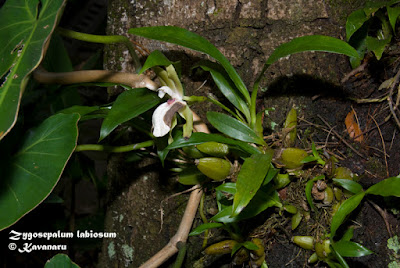Zygosepalum labiosum - The Lip-Like Zygosepalum is found in dense shade in wet montane forests at elevations below 1200 meters above sea level...
Zygosepalum labiosum, also called as The Lip-Like Zygosepalum, Epidendrum labiosum, Eulophia rostrata, Menadenium labiosum, Menadenium rostratum, Zygopetalum labiosum, Zygopetalum rostratum, Zygosepalum rostratum, is a species the genus Zygosepalum. This species was described by Charles Schweinfurth in 1967.
IDENTIFY ZYGOSEPALUM LABIOSUM - THE LIP-LIKE ZYGOSEPALUM
Zygosepalum labiosum is native to South Tropical America. It is
found in dense shade in wet montane forests at elevations below
1200 meters above sea level in Brazil North, Brazil Northeast, Brazil
West-Central, Colombia, French Guiana, Guyana, Peru, Suriname, Venezuela.
It is a medium sized, hot to warm growing, climbing epiphyte that has scandent rhizomes with a remote, oblong to ovate-pyriform, complanate pseudobulb. It has 2 to 3, basal pairs of distichous, imbricate sheaths with the uppermost being leaf bearing and 2 apical, oblanceolate, acuminate, plicate, conduplicate and imbricate at the short, petiolate base, subcoriaceous, carinate mid-vein, dark green leaves.
The Lip-Like Zygosepalum blooms in the spring and early summer from the erect, 20 cm long, 1 to 3 flowered, bracteate inflorescence arising on a mature pseudobulb and held below the leaves, with lanceolate, acuminate bracts. The flowers are are up to 10 cm in width, with greenish sepals and petals with red markings at their base, fragrant, long-lasting, simultaneously opening. The lip is white with a violet callus and violet veins.
ZYGOSEPALUM LABIOSUM - THE LIP-LIKE ZYGOSEPALUM CARE AND CULTURE
Cultural information should only be used as a guide, and should be to be adapted to suit you. Your physical location; where you grow your plants, how much time you have to devote to their care, and many other factors, will need to be taken into account. Only then can you decide on the cultural methods that best suit you and your plants.
Light:
Zygosepalum labiosum belongs to the shade-loving orchids, so for its successful cultivation, the intensity of illumination should be 20000-30000 lux. This plant feel best on relatively bright northern windows, but also the windows of the eastern and western orientation.
Temperature:
The Lip-Like Zygosepalum grow best at summer temperature of 15-30 ° C, winter temperature of 10-20 ° C. The most suitable temperature for the winter is 16-18 ° C. During the summer heat, the growth of new shoots may slow down. If the temperature is lowered, the orchid will continue its growth further.
Humidity:
This orchid need the humidity level of 50-80%. This orchid do not tolerate temperatures above 30 ° C. If, however, it is impossible to avoid exposure to high temperatures, the humidity of the air must be increased together with the temperature. This will help the plant better survive the forced heat.
Substrate, growing media and repotting:
Zygosepalum labiosum is grow mainly in pots. As a substrate, a mixture of coniferous bark and peat is best. The best time for transplant is the period immediately after flowering and until the moment when new shoots reach a size of 5 cm and begin to build their own roots. The roots grow large, so the plant should be repotted when needed.
Watering:
During the period of new growth, the plant needs frequent and abundant watering. Between watering the substrate should dry well, but do not dry completely. Excess water during watering should flow freely out of the pot, as the stagnation of water both inside the pot and in its pan can very quickly lead to decay of the roots and the lower part of the plant. Spraying is highly not recommended.
Fertilizer:
During the new growth period, the plant is fertilized every 2 weeks in a concentration of 0.5 ml of fertilizer per 1 liter of water. Fertilize this species is recommended only through the roots.
Rest period:
Zygosepalum labiosum needs a clearly defined period of rest to stimulate flowering. It begins immediately after the maturation of new bulbs, i.e. when new young shoots reach the size of the old, and is that the orchid contains much drier than usual, and does not fertilize. The water in this period should either be abandoned completely, or replace it with a light spray of the substrate. This period should not be more than once in 3-4 weeks. With the appearance of new shoots, the rest period ends, and watering resumes to the usual volume.















COMMENTS